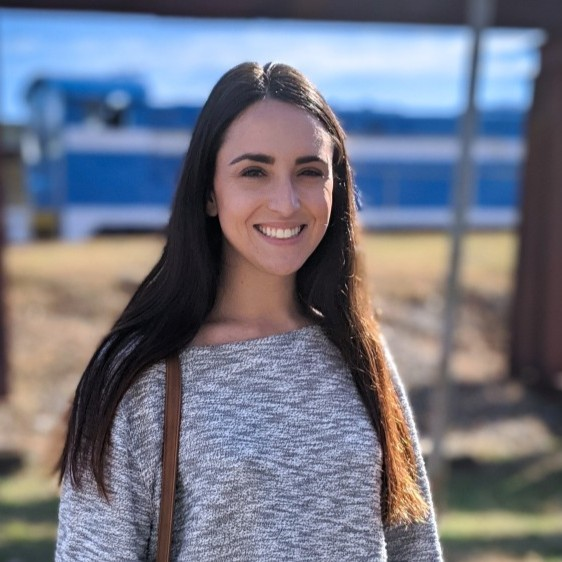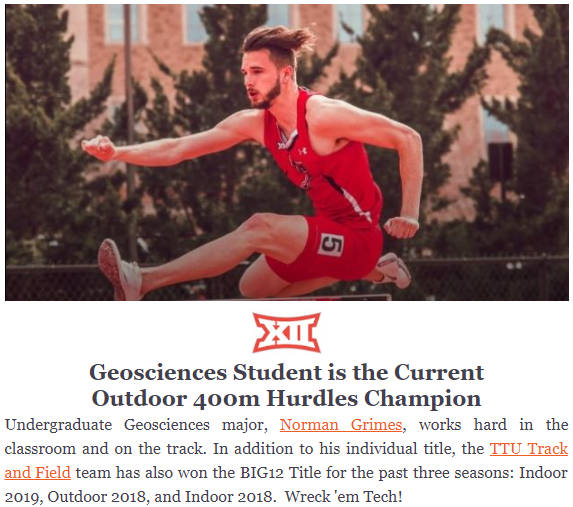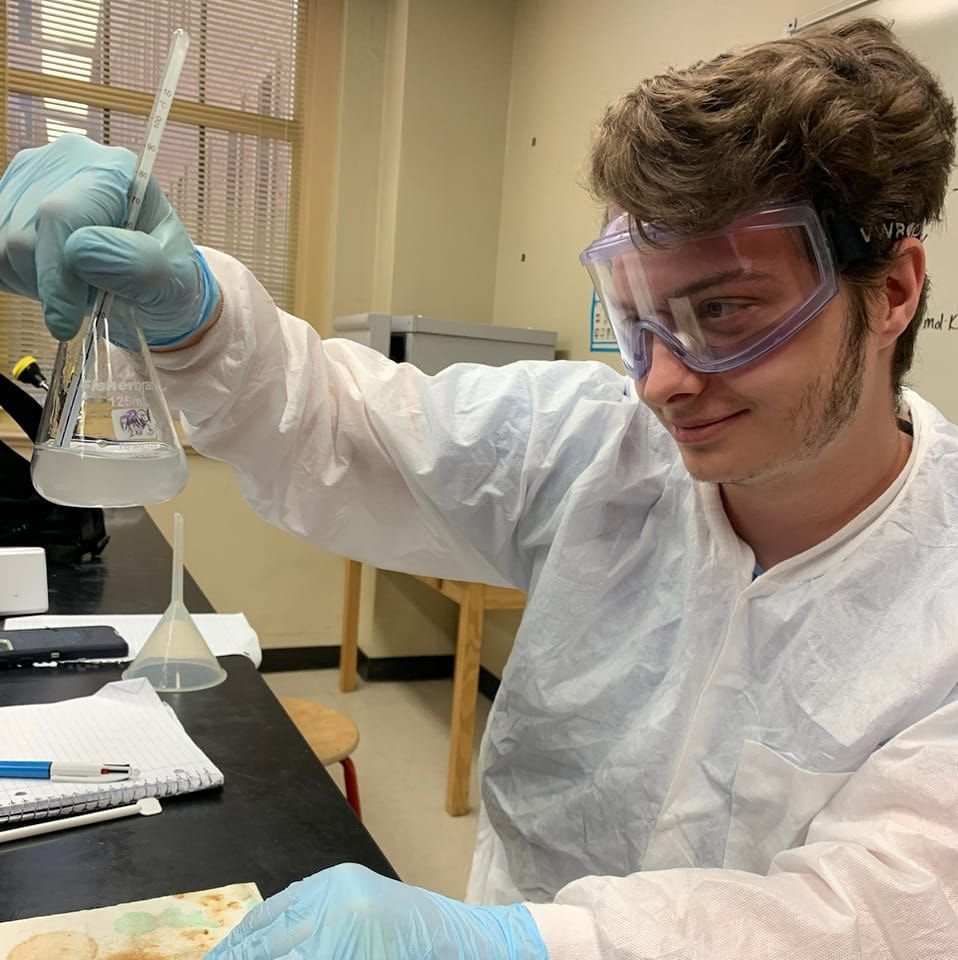
Student Spotlight
Meet Keely Patelski
Keely Patelski is an inaugural member of the Risk and Equity in Disasters (RED) Lab,
co-directed by Dr. Jen Henderson and Dr. Rodolfo Hernández in Geography. She was instrumental
in helping to design our RED Lab website and has helped with NOAA-funded research
endeavors, including the Envision Lubbock workshop in November 2022 with Estacado
and Frenship high school students. Last summer, Keely received a competitive NSF REU
fellowship to spent two months at the Natural Hazards Engineering Research Infrastructure
RAPID facility at the University of Washington in Seattle. There, she learned to use
different types of equipment, such as drones, LiDAR, and the z-boat, to study hazards.
She presented her work at a research symposium at the end of summer, a collaboration
with Rebecca Napolitano and Saanchi Singh Kaushai from Penn State. Based on the Quad-state
tornadoes of December 2021, in Mayfield, KY, Keely used UAV and Lidar data collected
by a team in March 2022 to produce accurate combined Structure-from-Motion (SfM) and
LiDAR point cloud models of the damaged historic masonry buildings in Mayfield. Her
paper can be found at DesignSafe CI. Keely is currently applying for graduate school
programs in Geography, including the M.S. program here at Texas Tech University having
graduated Magna Cum Laude.
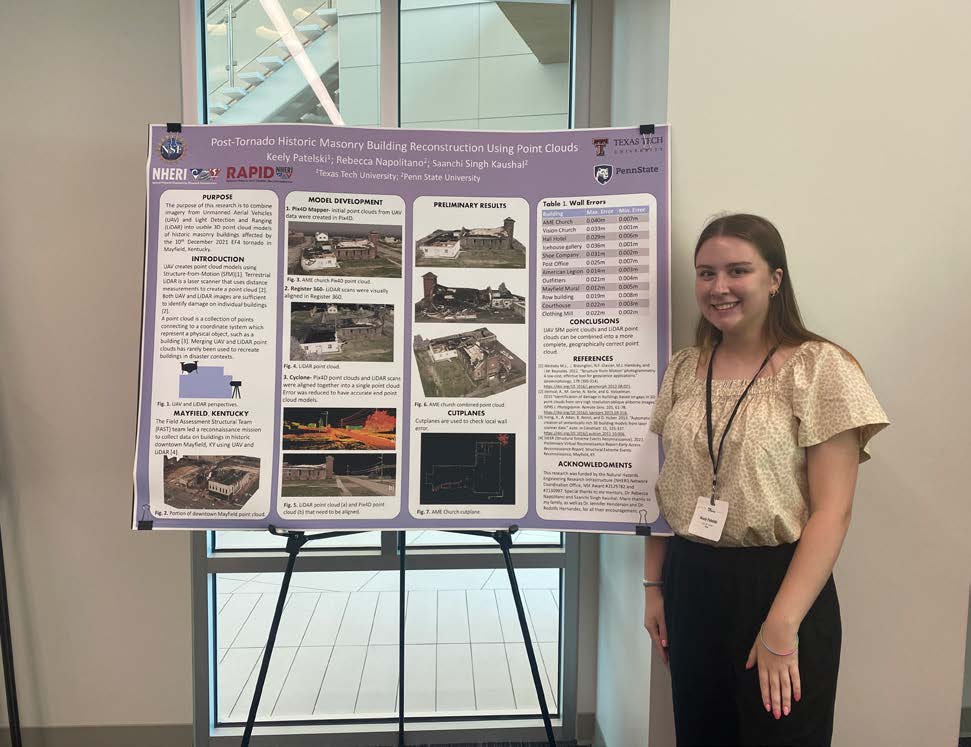
Helen DeVitt Jones Fellowship is one of the prestigious fellowship in Texas Tech University. Which was established in 2003 from the generous donation from the Helen Jones Foundation. The Helen Jones Fellows is recruited and selected from the most outstanding graduate students available.“It is my great honor to tell you that I have received Helen DeVitt Jones Fellowship for the year 2022-2023,” Tarek. With support from donations to the Department, Tarek was able to attend STOREP 2022: “Economics and the Economic System: The Ecological Transition”. Tarek wrote about his experience here:STOREP annual conference 2022 was organized in Viterbo, Italy focusing the young researchers to come up with innovative ways to navigate the EcologicalTransition. I have presented my paper on ‘Geospatial analysis of flood risk and exploring the feasibility of flood micro-insurance in Bangladesh' under regional environmental case studies. I was able to attend numerous sessions. I gained valuable experience that could not be obtained anywhere else. I was able to focus on topics that directly relate to my ongoing research and find some innovative ideas that will help me in my present research. In addition to the conference sessions, the chance to network with other colleagues in similar situations was an extremely valuable experience. I was able to speak with several experts who provided tips and useful information for my particular dilemmas and work projects. I want to thank department of Geoscience, Texas Tech University for giving me the opportunity to go and present my research in STOREP 2022 conference.
by Logan Fink
This was a weeklong research camp focusing on Rare Earth Elements in hydrothermal
solutions. This camp was a neat introduction into hydrothermal processes in a geologic
context as well as the formation of ores with Rare Earth elements. We has several
lectures on these topics as well as some time in the microscopy lab to view this sections
of hydrothermal veins of carbonatite and fluorite that we viewed in the field trip
in the previous day. We also had a day of 100% lab work where we were introduced and
taught how to use machines such as UV-Vis, X-ray diffraction, Raman spectrometer,
And two ICP machines I believe ICP-OES and ICP-MS. After this we were given a rudimentary
review of thermos dynamics to prepare us for using the thermodynamic modeling software
GEMS where we were taught and made our own model of a roc alteration process using
the MINES database. This Camp was a great introduction to the classes I am about to
take but also made it a little challenging to understand something but overall this
camp is a great experience for anyone trying to figure out what hey want to do. It
gives you a taste of geochemistry, minerology and a little economic geology and would
be a great camp for someone who wants to be in this field to get a good introductory
experience and to make contact with some people wo can help you succeed in the future.
It is also a very great way for a young aspiring geologist to get out there and make
some friend outside of your classroom that have similar career goals as you and who
can be a great resource in graduate school hunting, networking and much more.
Logan was also recently hired by Freeport-McMoRan for a summer internship focusted
on copper deposits. He will be in Silver City, NM.
Congratulations go out to Geosciences Undergraduate student Olivia Retería for being awarded a student award for the President's Excellence in Diversity, Equity & Inclusion Award!
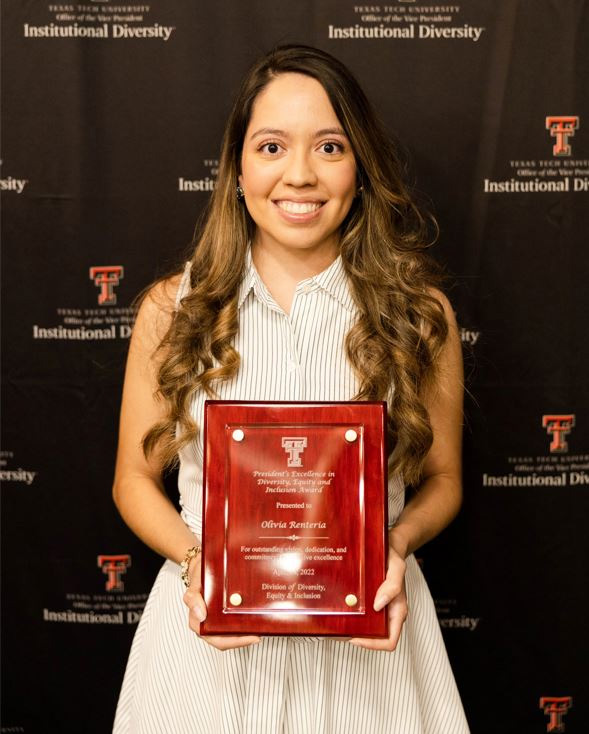
by Emily Fischer
National Science Foundation Research Fellowship Recipient
I grew up in Richmond Hill, GA, which is located about 15 minutes from Savannah. In 2020, I completed undergrad at Georgia Southern University, after taking a few years off to figure out what I really wanted to do. I worked in the restaurant industry and had an opportunity to work as the bar manager for a summer at Mountain Sky Guest Ranch in Emigrant, MT. While I was there, I visited Yellowstone National Park for the first time. During my first backpacking trip at the park, while hiking, I remember asking myself how the mountains formed and why they looked so different from the southern Appalachians that I grew up exploring. I was already interested in the outdoors and that experience prompted me to look into careers where I could combine my love of the outdoors with my desire to find out how the earth works. That's when I discovered geology. I went back to school, and because GSU has a small geology department with no graduate program, I was able to become actively involved in Geo Club and class field trips. After my igneous petrology course, my professor suggested I pursue a senior thesis in the subject. During my first trip to collect samples, while holding a 300 million-year-old rock in my hand that no person had ever touched, it suddenly clicked. I was essentially a forensic scientist unravelling the story of that rock. I was hooked. That experience solidified my interest in research and helped crystallize my curiosity of magmatic processes.
Studying Abroad in Dublin
Spring 2019
By: Daniel Lavery
In the Spring of 2019, instead of making the 9-hour drive from Houston to Lubbock, I took a 9-hour flight to Dublin, Ireland for a semester at University College Dublin. The whole semester put me out of my comfort zone, which resulted in my growth as a person and student.
None of the geosciences courses I registered for had any exact equivalent course at Tech, but the classes helped me in ways that my transcript could not show. A class titled Earth Structure and Geodata began as a review of Geophysics, which I had taken the previous semester at Tech, but by the end of the course, we were studying the beginning portion of Dr. Yoshinobu's Structural Geology course. Another course, Introduction to Field Mapping, included a week-long field trip to Co. Galway to practice geological mapping. The week was a learning experience on keeping a field notebook, making maps, and the best way to safely hop a barbed-wire fence to escape the sheep in that pasture that are beginning to act aggressively. With the exception of the sheep-induced fence-jumping, all of the skills I learned in that course have directly helped me in Structural Geology, I hope I can continue to use those mapping skills in a future job.
The courses I took in Dublin have made me more confident in my reasoning skills. The panicky feeling I felt as a freshman when asked to identify a rock in the Physical Geology lab has dissipated, which I would consider a good step in the right direction. Besides the classroom learning, simply living in Ireland for a semester was good learning experience for dealing with new situations, especially the logistics of traveling and responding flexibly to changes of plan. Some of these new situations involved breaking in my new trail-running shoes as I trail-ran away from an approaching storm on the Causeway Coast in Northern Ireland (I lost that footrace when the wind tossed me into a barbed wire fence). I also learned that hitchhiking is not the best (quite possibly the worst) mode of transportation to the port at Holyhead in Wales when you miss your train there. I also learned in the Caving Society how to rig myself up to ascend and descend on ropes into one of many limestone caves in Co. Cavan.
I feel better prepared for further schooling and hopefully a career in geology. I plan to attend graduate school, but I do not know where or what concentration to study. My semester in Dublin taught me to be flexible and to keep my options open, so that is my plan for now.
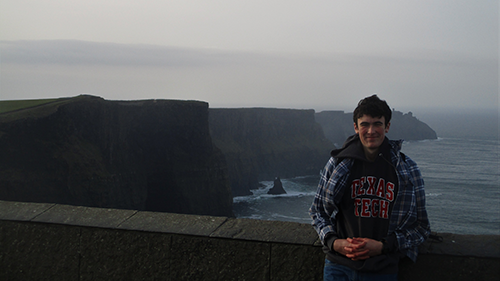
Occupational Hazards: Texas Tech's Participation in the Hazardous Weather Testbed
by Austin Coleman (M.S. student)
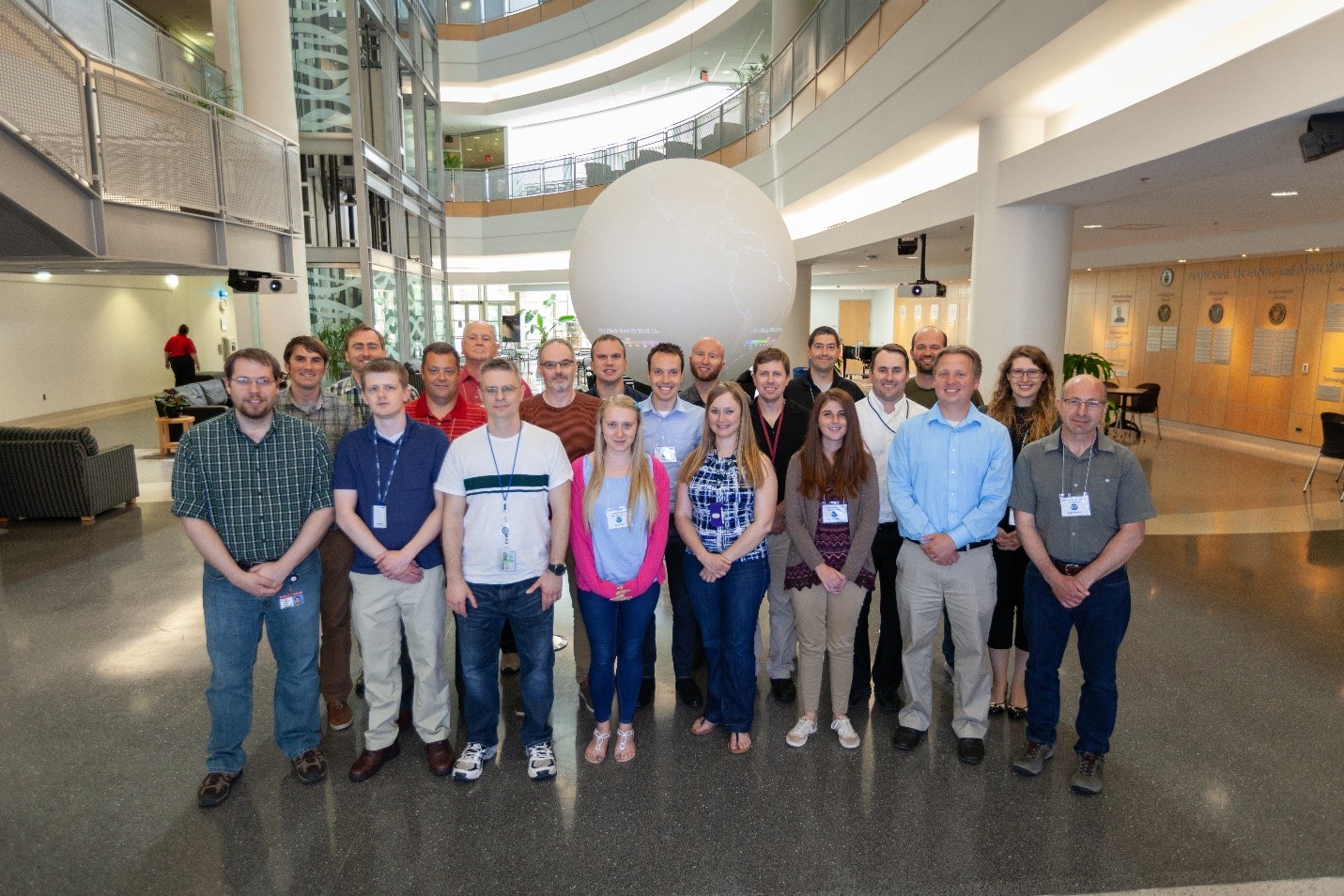 Experimental Forecast Program team May 2019, Austin pictured in front row, third from
right, Dr. Brain Ancell directly behind Austin on back row.
Experimental Forecast Program team May 2019, Austin pictured in front row, third from
right, Dr. Brain Ancell directly behind Austin on back row.
Occupational Hazards: Texas Tech's Participation in the Hazardous Weather Testbed
On any typical spring day in May at the National Weather Center in Norman, Oklahoma, there's more brewing than just storms and coffee. Up the stairs and to the left one walks into a glass room abuzz with the exchange of ideas from one of the most professionally diverse group of meteorologists in the world. This is the NOAA's Hazardous Weather Testbed Spring Forecasting Experiment, and this May will mark its twelfth year of conduction. In a nearly literal realization of research to operations, the HWT SFE brings together meteorological researchers and forecasters alike to put a suite of cutting-edge forecast products to the test - by using them to forecast severe weather in real time! Divided into two programs, the Experimental Forecast Program and the Experimental Warning Program, this effort is pivotal to the improvement of forecasts on multiple time scales, from increasing tornado lead times to improving the spatial accuracy of 24-hour hail forecasts.
I first experienced the HWT SFE Experimental Forecast Program last May, although my advisor's (Dr. Brian Ancell) research group has been participating regularly over the past five years. Brian, Aaron Hill (TTU PhD student), and I led evaluation on a product we developed to improve computer model forecasts of hazardous weather at 12- to 48-hour lead times. The technique uses a data mining approach to siphon out early forecast aspects relevant to the prediction of a later high-impact weather event and uses that important information to improve the model forecast. Up to that point my research focused on verifying and optimizing the technique objectively, and seeing the product evaluated from a forecasting perspective was truly eye-opening!
Every week, a new group of forecasters and researchers participated in the program, bringing new perspectives along with them. After explaining how the product works, we would identify the “forecast problem of the day” and focus the post-processing technique on that geographical region. The next day, we verified the forecasts together by comparing the performance of pre-processed Texas Tech model forecasts (link to the TTU system below) with our post-processed model forecasts and discussed the differences. Oftentimes, participants were interpreting and using the technique in ways that I had not previously considered. The diversity of perspectives was instrumental in going forward with the technique and solidified how crucial interdisciplinary perspectives are to a scientific conversation. This year, we return to the HWT with a similar product applied to a much broader suite of models called the CLUE (or the Community Leveraged Unified Ensemble – we meteorologists really do love our acronyms), and with potential for an active severe weather season, I am sure fascinating discoveries await!
The Hazardous Weather Testbed represents an innovative path towards the ultimate end goal of saving lives and property. By bringing researchers and forecasters into one room for an extended period we can better identify the shortcomings in current forecasting and warning techniques, explore proposed solutions to forecasting challenges, and push the boundaries of science. And of course, would it truly be a forecasting experiment without spending some time experiencing the storms being forecast?
Department of Geosciences
-
Address
Department of Geosciences, 1200 Memorial Circle, Lubbock, TX 79409-1053 -
Phone
806.742.3102 -
Email
geosciences@ttu.edu

